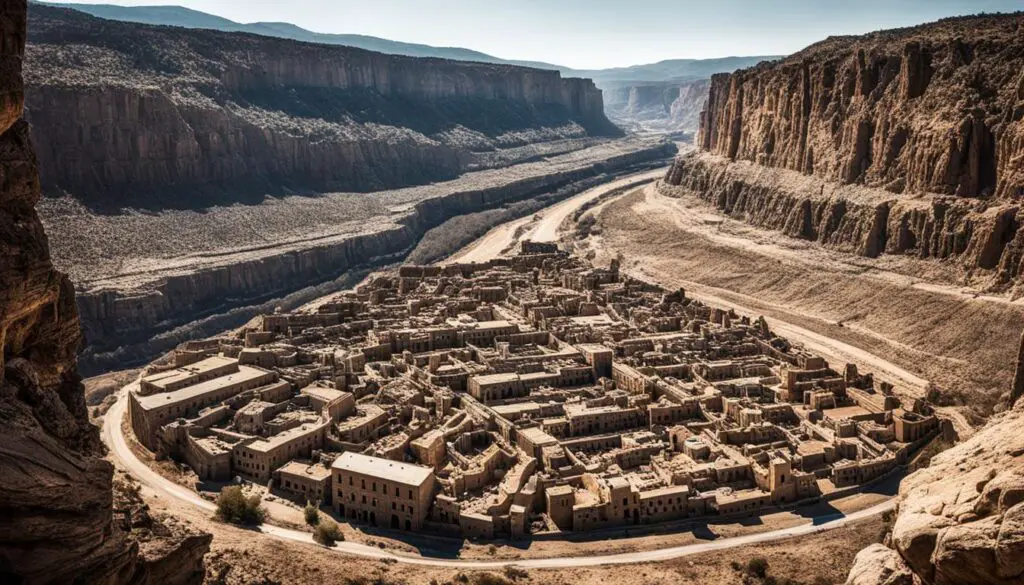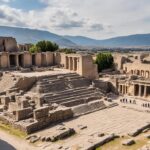Welcome to our exploration of the fascinating biblical city of Zoar mentioned in the Bible. Also known as Zoara and Bela, this ancient city holds both historical and theological significance. Let’s delve into the details of Zoar’s biblical reference, its location, and its role in key biblical events.
Located in the Dead Sea basin in the Transjordan region, Zoar is described in the Book of Genesis as one of the “cities of the plain.” It provided refuge for Lot and his daughters during the destruction of Sodom and Gomorrah. Zoar’s mention in various ancient sources and its thriving oasis with indigo production and date trees add to its significance in the history of the region.
Join us as we uncover the historical, geographical, and archaeological aspects of Zoar, as well as its theological themes and cultural practices. Let’s also explore its prophetic and eschatological significance, as well as its place in Christian tradition. Zoar’s story is a captivating journey that intertwines the tapestry of biblical narratives and historical inquiry.
Key Takeaways:
- Zoar played a significant role in biblical events, particularly as a refuge for Lot and his daughters during the destruction of Sodom and Gomorrah.
- The city of Zoar was located in the Dead Sea basin in the Transjordan region, known for its fertile valley and proximity to the Dead Sea.
- Archaeological discoveries in the region of Zoar have provided insights into the ancient city’s existence and culture.
- Zoar carries theological themes highlighting divine protection, salvation, and the consequences of righteousness and wickedness.
- The inclusion of Zoar in Christian tradition as a bishopric further solidifies its historical and religious significance.
Historical Significance of Zoar in the Bible
Zoar holds great historical significance as one of the ancient cities mentioned in the Bible. Along with Sodom, Gomorrah, Admah, and Zeboim, it was one of the renowned “cities of the plain.” While the neighboring cities faced destruction, Zoar was spared and offered refuge to Lot and his daughters. This historical event establishes Zoar’s connection to the patriarchal age and its crucial role in the biblical narrative of Sodom and Gomorrah.
Geographical Location of Zoar in the Bible
Zoar was a biblical city located in the Dead Sea basin in the Transjordan region. It was situated in close proximity to the Dead Sea and was believed to be at the modern-day Ghor es-Safi in Jordan. The city occupied a strategic location along the lower Jordan Valley and the Dead Sea plain, making it ideal for settlement and agricultural practices. The geographical location of Zoar holds immense significance in biblical narratives and provides valuable insights for historical studies.
With the Dead Sea nearby, Zoar benefited from the fertile valley and favorable climate, enabling the cultivation of various crops and plants. Its location in the Transjordan region positioned it as a prominent city within ancient biblical territories.
According to the Book of Genesis, Zoar served as a place of refuge for Lot and his daughters during the destruction of Sodom and Gomorrah. This historical event highlights the strategic importance of Zoar’s geographical location and its role in providing safety and sanctuary.
To better understand Zoar’s geographical context, let’s take a look at the following table:
| Location | Region |
|---|---|
| Ghor es-Safi, Jordan | Transjordan |
| Along the lower Jordan Valley | |
| Near the Dead Sea |
The table provides a concise overview of Zoar’s geographical location, emphasizing its presence in the Transjordan region, along the lower Jordan Valley, and its proximity to the Dead Sea.
To further enhance our understanding of Zoar’s geographical significance, let’s examine a relevant quote:
“Zoar, located in the Dead Sea basin near the lower Jordan Valley, played a vital role in biblical narratives as a place of refuge and safety during the destruction of Sodom and Gomorrah.”
This quote underscores the crucial role that Zoar’s geographical location played in biblical events, emphasizing its significance in providing shelter and protection.
Now we have gained valuable insights into the geographical location of Zoar within the Transjordan region and its proximity to the Dead Sea. The next section will delve into the archaeological discoveries made in Zoar, shedding light on its rich historical past.
Archaeological Discoveries of Zoar
Archaeological excavations and surveys have been conducted in the region of Zoar, particularly at the site of Tall el-Hammam. These Zoar archaeological discoveries have revealed ancient ruins and artifacts that provide fascinating insights into the history and culture of Zoar.
One noteworthy discovery is the ruins of a basilical church, identified as the Sanctuary of Saint Lot, which was found at the site of Deir ‘Ain ‘Abata. This ancient structure offers a glimpse into the religious practices and architecture of the time.
Additionally, a mixed Christian-Jewish cemetery with engraved funerary steles was uncovered in the Khirbet Sheikh ‘Isa area, shedding light on the diverse religious and cultural influences present in Zoar during its ancient heyday.
These remarkable Zoar excavation findings contribute significantly to our understanding of Zoar’s existence as an ancient city, as well as the lives and beliefs of its inhabitants.
| Archaeological Discoveries | Location |
|---|---|
| Ruins of the Sanctuary of Saint Lot | Deir ‘Ain ‘Abata |
| Mixed Christian-Jewish Cemetery | Khirbet Sheikh ‘Isa area |
Theological Themes in Relation to Zoar in the Bible
Zoar, an ancient city mentioned in the Bible, carries profound theological significance and spiritual meaning. One of its prominent themes is its role as a place of refuge during the destruction of Sodom and Gomorrah. This narrative highlights the divine protection and salvation provided to those who seek shelter in the presence of God. Zoar serves as a symbol of God’s mercy, offering a stark illustration of the consequences that accompany righteousness and wickedness.
“And Lot said to them, ‘Oh, no, my lords! Behold, your servant has found favor in your sight, and you have shown me great kindness in saving my life. But I cannot escape to the hills, lest the disaster overtake me and I die. Behold, this city is near enough to flee to, and it is a little one. Let me escape there—is it not a little one?—and my life will be saved!'”
The inclusion of Zoar in the Bible reinforces the moral and ethical lessons embedded within its stories. Through Zoar’s narrative, we are reminded of the importance of seeking refuge in God’s grace, as well as the consequences of embracing wickedness and straying from His path.
Readers are encouraged to contemplate the spiritual implications of Zoar’s biblical account, allowing its teachings to guide their own lives and relationship with the divine.

Zoar’s theological significance resonates with readers, offering spiritual insights and guiding principles for navigating life’s challenges.
Key Biblical Events in Zoar
Zoar, mentioned in the Book of Genesis, is associated with several key biblical events that highlight its significance in biblical narratives. One of its prominent mentions is as the city to which Lot and his daughters fled for refuge after the destruction of Sodom and Gomorrah. The biblical narrative emphasizes Zoar’s role in providing a safe haven for Lot and his family during this catastrophic event.
The story of Lot and the refuge he found in Zoar showcases themes of faith, redemption, and divine intervention. Despite the surrounding destruction, Zoar served as a place of salvation and protection, demonstrating God’s mercy and the significance of finding shelter in times of tribulation.
The biblical events in Zoar serve as lessons of trust, resilience, and the ultimate reward that comes from placing faith in higher powers. They inspire readers to seek refuge and solace, even in the face of adversity, trusting in the divine plan and finding security in the protection offered by God.
“And when they brought them out, one said, ‘Escape for your life. Do not look back or stop anywhere in the valley. Escape to the hills, lest you be swept away!’ Lot said to them, ‘Oh, no, my lords. Behold, your servant has found favor in your sight, and you have shown me great kindness in saving my life. But I cannot escape to the hills, lest the disaster overtake me and I die. Behold, this city is near enough to flee to, and it is a little one. Let me escape there–is it not a little one?–and my life will be saved!'”
| Biblical Event | Description |
|---|---|
| Lot’s Escape to Zoar | After the destruction of Sodom and Gomorrah, Lot and his daughters sought refuge in Zoar, a city spared from the destruction. |
| Faith and Divine Intervention | Lot’s decision to flee to Zoar demonstrated his trust in God’s guidance and divine intervention during times of calamity. |
| God’s Protection and Mercy | Zoar served as a place of safety and salvation, illustrating God’s mercy and the importance of finding shelter in times of crisis. |
Cultural and Religious Practices in Zoar
The ancient society of Zoar had intriguing cultural and religious practices that shaped their daily life and economic activities. While limited documentation exists, historical accounts reveal some fascinating aspects of their society.
Zoar was renowned for its prosperous and flourishing oasis nature, which played a significant role in their cultural practices. The city’s inhabitants engaged in the production of indigo, a highly valued dye in ancient times. This craft not only contributed to the economic prosperity of Zoar but also showcased their artistic and creative abilities.
Religious practices in Zoar likely revolved around their cultivation of date trees, which held spiritual and symbolic significance. Dates were not only a staple in their diet but also held religious associations in various ancient cultures. The act of cultivating date trees may have been accompanied by rituals and ceremonies that honored their connection to the divine.
Historical accounts suggest that Zoar’s culture was deeply intertwined with their natural surroundings, with religious and economic activities centered around the flourishing oasis and its abundant resources.
Key Aspects of Cultural and Religious Practices:
Below are some key aspects of the cultural and religious practices in the ancient society of Zoar:
- Production of indigo, a highly valued dye
- Cultivation and reverence of date trees
- Integration of religious rituals and ceremonies
- Association of economic activities with cultural traditions
While the full extent of Zoar’s cultural and religious practices remains shrouded in mystery, these glimpses into their ancient society provide us with valuable insights into their way of life and their deep connection to their surroundings.

*Image: Cultural and religious practices in the ancient society of Zoar*
Prophetic and Eschatological Significance of Zoar
Zoar, as mentioned in biblical texts, carries profound prophetic and eschatological significance. In the book of Isaiah, Zoar is referenced in connection with the nation of Moab, hinting at a broader context of judgment and restoration within the region. This allusion suggests that Zoar is not just an ordinary city but holds a deeper spiritual meaning in relation to the divine plan.
The eschatological significance of Zoar may not be explicitly mentioned in biblical texts, but its inclusion in the Bible and its association with key biblical events contribute to discussions on biblical prophecy and end-times interpretations. The city’s role as a place of refuge during the destruction of Sodom and Gomorrah, and its subsequent preservation, can be seen as symbols of God’s mercy and protection during times of divine judgment.
“And a swift messenger shall come against the strong…. He shall come to Zion, and unto them that turn from transgression in Jacob, saith the LORD…. He shall cause them that come of Jacob to take root: Israel shall blossom and bud, and fill the face of the world with fruit. Hath he smitten him, as he smote those that smote him? or is he slain according to the slaughter of them that are slain by him? In measure, when it shooteth forth, thou wilt debate with it: he stayeth his rough wind in the day of the east wind. By this therefore shall the iniquity of Jacob be purged; and this is all the fruit to take away his sin;…. And he said, A lion: My righteousness is near; my salvation is gone forth, and mine arms shall judge the people [the Moabites]; the isles shall wait upon me, and on mine arm shall they trust.”
– Isaiah 27:7-10
This scripture passage from Isaiah provides a glimpse into the prophetic and eschatological significance of Zoar within the larger context of divine judgment and restoration. It highlights the importance of discerning biblical symbols and their implications for understanding the future events foretold in the Bible.

| Prophetic Significance | Eschatological Meaning |
|---|---|
| Symbolizes divine protection during times of judgment | Linked to biblical prophecies and end-times interpretations |
| Represents God’s mercy and salvation | Points towards the fulfillment of biblical promises and restoration |
| Connects Zoar to the nation of Moab in prophetic contexts | Provides insights into the unfolding of future events |
The prophetic and eschatological significance of Zoar invites deeper exploration and analysis in biblical studies. By discerning the spiritual meaning and symbolism embedded in biblical texts, we can gain a greater understanding of God’s plan for humanity and the role Zoar plays within it.
Zoar in Other Ancient Sources
Zoar’s historical and biblical significance is further corroborated by references in various ancient sources, including the works of Josephus, Ptolemy, and Eusebius.
Josephus, a renowned Jewish historian from the 1st century CE, mentions Zoar in his writings, providing valuable insights into the city’s existence and historical context.
Ptolemy, a prominent Greek geographer and astronomer, also refers to Zoar in his extensive geographical work. His mention of Zoar contributes to our understanding of the city’s significance within the region.
Eusebius, an early Christian historian and scholar, includes references to Zoar in his geographical writings. These references further establish the importance of Zoar in ancient times.
Together, these ancient sources provide additional historical and geographical context, reinforcing the significance of Zoar as an ancient city and its role within biblical narratives.

Zoar in Christian Tradition
Zoar holds a significant place in Christian tradition, particularly due to its status as a bishopric. As part of the late Roman province of Palaestina Tertia, Zoar became a bishopric with multiple bishops mentioned in historical records. The Catholic Church recognizes Zoar as a suppressed and titular see. The city’s inclusion in Christian tradition further adds to its already rich historical and religious significance.
Conclusion
The exploration of Zoar in the Bible reveals its rich historical, geographical, archaeological, theological, and cultural significance. The city’s role in biblical narratives, such as providing refuge to Lot and his daughters during the destruction of Sodom and Gomorrah, highlights its importance in biblical contexts.
Zoar’s geographical location in the Transjordan region, near the Dead Sea basin, further adds to its significance. The city’s proximity to the Dead Sea and its fertile valley made it an ideal location for settlement and agricultural practices in ancient times.
Archaeological discoveries at sites like Tall el-Hammam and Deir ‘Ain ‘Abata have unearthed ancient ruins and artifacts, shedding light on Zoar’s existence as an ancient city. These findings contribute to our understanding of Zoar’s place in history and its impact on ancient societies.
Zoar’s inclusion in Christian tradition, recognized as a suppressed and titular see, solidifies its position as both a religious and historical site. The exploration of Zoar showcases the depth and richness of biblical history and its continuing relevance in contemporary studies.







